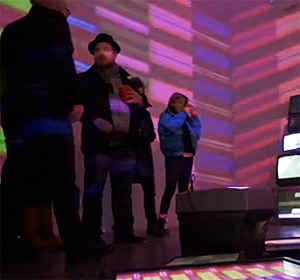11.3.23 — Roots: As Seen on TV
One goes to Wave Hill for the richness of nature, all the more so in that nature is filtered through art. That includes the picture perfect views and perfectly mannered lawns. Nature at its wildest, in the broad, twisting trunk of a silvery white copper beech, bears a plaque with its family, genus, and species.
It included, too, the summer show of winter artists in residence, with their own delight in landscapes, real and imagined—very much like the landscape in which they appear. This year’s crop sees it all as an extension of their personal and cultural heritage, but there is more lasting past summer. For LoVid, at the far end of a pristine lawn, that heritage is still running on network TV.  I also wrap this together with an earlier report on the Brooklyn Waterfront as a longer review and my latest upload.
I also wrap this together with an earlier report on the Brooklyn Waterfront as a longer review and my latest upload.
For the eight artists in “This Place We Once Remembered,” which ran through August 6, cherished memories are all too easy to lose apart from art. They still have their sense of place, but where? Is it Wave Hill’s Glyndor Gallery, in the Bronx by the Hudson? For Dana Levy, the mansion appears, as one title has it, as A Ghost from the Future. Is it her half-remembered media, of stained glass and a magic-lantern slide show? Is it her ghostly prints or all in her head?
Is it the sunroom, where a ninth artist, Jacq Groves, constructs seeming fragments of flesh and bone, along with the folk remedies that he hoped would keep them alive? Is it Israel, Germany, Egypt, Japan, Brooklyn, and the Afro-Caribbean diaspora, where the cast has its roots? Ezra Wube presents Ethiopia as a seeming paradise, but his stop-action animation gives voice to interviews with the country’s inhabitants as mostly lost hopes. Is it the ground at her feet for Ariel (or Aryel) René Jackson, which to her is ancestral ground? She invokes it in a loose grid of soil, lime, and cement. As Paloma McGregor puts it in performance, in the language of St. Croix, All of Us Are Here.
The artists share an interest in calling colonialism and history to account, although I do not always see it in their work. Yelaine Rodriguez dresses in white and feathers as a deity standing guard over shores and caves, but she is too busy dancing about and having fun. You may find yourself joining in. Saya Woolfalk claims an entire Encyclopedia of Cloud Divination, in prints and video, but the colorful flowers and human hybrids belong just as much to present-day cartoons and to Wave Hill. I did not catch performance by Zachary Fabri or Jodie Lyn-Kee-Chow, but I did head to Wave Hill House for more. There LoVid might be speaking for them all with “Tap Root,” through December 3, so there is still time to catch this one!
Video has roots, too, only not the kind that run deep into the soil. And LoVid has staked its name on looking outward and looking back. In a world of new media, its very name sounds low res and low tech. A title still wonders What’s on TV. At Wave Hill, the work itself is digitally printed, but on fabric. In a high-tech world, too, a woman’s work is never done.
In real life (or make that IRL), LowVid is male (as Tali Hinkis and Kyle Lapidus), with a man’s due certainty. That title without a question mark is not asking you what’s on TV but telling you, and they have every right. They did, after all, convert a room in 2014 into a compendium of TVs, from the first picture tubes to the latest and smartest. It went quite well with the Experimental Television Center elsewhere that year, and it would go quite well with “Signals” at MoMA this past spring. Here, though, they bring something new, a touch of craft and a touch nature. In work from the last three years, nearly every print is a landscape, complete with flowers, spiders, and tendrils.
One landscape picks up on Wave Hill’s luxuriant greenhouse, where more plants spill out on the grounds out front. Larger prints have the scale and patterning of tapestries. (One must step carefully around diners in the café to see them.) If tapestry is a decorative art, these take their patterns from good old low-res pixilation, with distorted colors to match. One more title captures the ambiguity, as Music for Alpines, a pun on Music for Airports. Brian Eno’s high-tech background music has become a room with a view.
Read more, now in a feature-length article on this site.